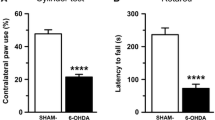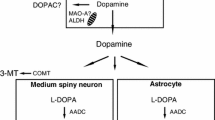Summary
This study examines the hypothesis that glutamate tonically suppresses the activity of the enzyme aromatic L-amino acid decarboxylase (AADC), and hence the biosynthesis of dopamine, to explain how antagonists of glutamate receptors might potentiale the motor actions of L-DOPA in animal models of Parkinson's disease. A variety of glutamate antagonists were therefore administered acutely to normal rats, which were sacrificed 30–60 min later and AADC activity assayed in the substantia nigra pars reticulate (SNr) and corpus striatum (CS). The NMDA receptor-ion channel antagonists MK 801, budipine, amantadine, memantine and dextromethorphan all caused a pronounced in creased in AADC activity, more especially in the SNr than CS. The NMDA glycine site antagonist (R)-HA 966 produced a modest increase in AADC activity in the CS but not SNr, whilst the NMDA polyamine site antagonist eliprodil, the NMDA competitive antagonist CGP 40116 and the AMPA antagonist NBQX were without effect. The results suggest that an increase in dopamine synthesis might contribute to the L-DOPA-facilitating actions of some glutamate antagonists.
Similar content being viewed by others
References
Biggs CS, Fowler LJ, Whitton PS, Starr MS (1996) NMDA receptor antagonists increase the release of dopamine in the substantia nigra of reserpine-treated rats. Eur J Pharmacol 299: 83–91
Bonuccelli U, Del Dotto P, Piccini P, Behgé F, Corsini GU, Muratorio A (1992) Dextromethorphan and parkinsonism. Lancet 340: 53
Buckland PR, O'Donovan C, McGuffin P (1992) Changes in dopa decarboxyalse mRNA but not tyrosine hydroxylase mRNA levels in rat brain following antipsychotic treatment. Psychopharmacology (Berlin) 108: 98–102
Hadjiconstantinou M, Wemlinger TA, Sylvia CP, Hubble JP, Neff NH (1993) Aromatic Lamino acid decarboxylase activity of mouse striatum is modulated via dopamine receptors. J Neurochem 60: 2175–2180
Hadjiconstantinou M, Rosetti ZL, Wemlinger TA, Neff NH (1995) Dizocilpine enhances striatal tyrosine hydroxylase and aromatic L-amino acid decarboxylase activity. Eur J Pharmacol (Mol Pharmacol Sect) 289: 97–101
Jackisch R, Kruchen A, Sauermann W, Hertting G, Feuerstein TJ (1994) The antiparkinsonian drugs budipine and biperiden are use-dependent (uncompetitive) NMDA receptor antagonists. Eur J Pharmacol 264: 207–211
Kaur S, Starr MS (1995) Antiparkinsonian action of dextromethorphan in the reserpinetreated mouse. Eur J Pharmacol 280: 159–166
Kornhuber J, Bormann J, Hilbers M, Rusche K, Riederer P (1991) Effects of the 1-aminoadamantanes at the MK-801-binding site of the NMDA-receptor-gated ion channel: a human postmortem brain study. Eur J Pharmacol (Mol Pharmacol Sect) 206:297–300
Lowry OH, Rosebrough NJ, Farr AL, Randal RJ (1951) Protein measurement with the Folin phenol reagent. J Biol Chem 193: 265–275
Montastruc JL, Fabre N, Rascco O, Senard JM (1994) N-Methyl-D-aspartate (NMDA) antagonist and Parkinson's disease: a pilot study with dextromethorphan. Mov Disord 9: 242–243
Opacka-Juffry J, Brooks DJ (1995) L-Dihydroxyphenylananine and its decarboxylase: new ideas on their neuroregulatory roles. Movement Disorders 3: 241–249
Orosz D, Bennett JP (1992) Simultaneous microdialysis in striatum and substantia nigra suggests that the nigra is a major site of action of 1-dihydroxyphenylalanine in the hemiparkinsonian rat. Exp Neural 115: 388–393
Starr MS (1995a) Review: Glutamate/dopamine D1/D2 balance in the basal ganglia and its relevance to Parkinson's disease. Synapse 19: 264–293
Starr MS (1995b) Antiparkinsonian actions of glutamate antagonists — alone and with LDOPA: a review of evidence and some suggestions for possible mechanisms. J Neural Transm (P-D Sect) 10: 141–185
Zhu MY, Juorio AV (1995) Aromatic L-amino acid decarboxylase: biological characterization and functional role. Gen Pharmacol 26: 681–696
Zhu MY, Juorio AV, Paterson IA, Boulton AA (1992) Regulation of aromatic L-amino acid decarboxylase by dopamine receptors in the rat brain. J Neurochem 58: 636–641
Author information
Authors and Affiliations
Rights and permissions
About this article
Cite this article
Fisher, A., Biggs, C.S. & Starr, M.S. Effects of glutamate antagonists on the activity of aromatic L-amino acid decarboxylase. Amino Acids 14, 43–49 (1998). https://doi.org/10.1007/BF01345241
Received:
Accepted:
Issue Date:
DOI: https://doi.org/10.1007/BF01345241




